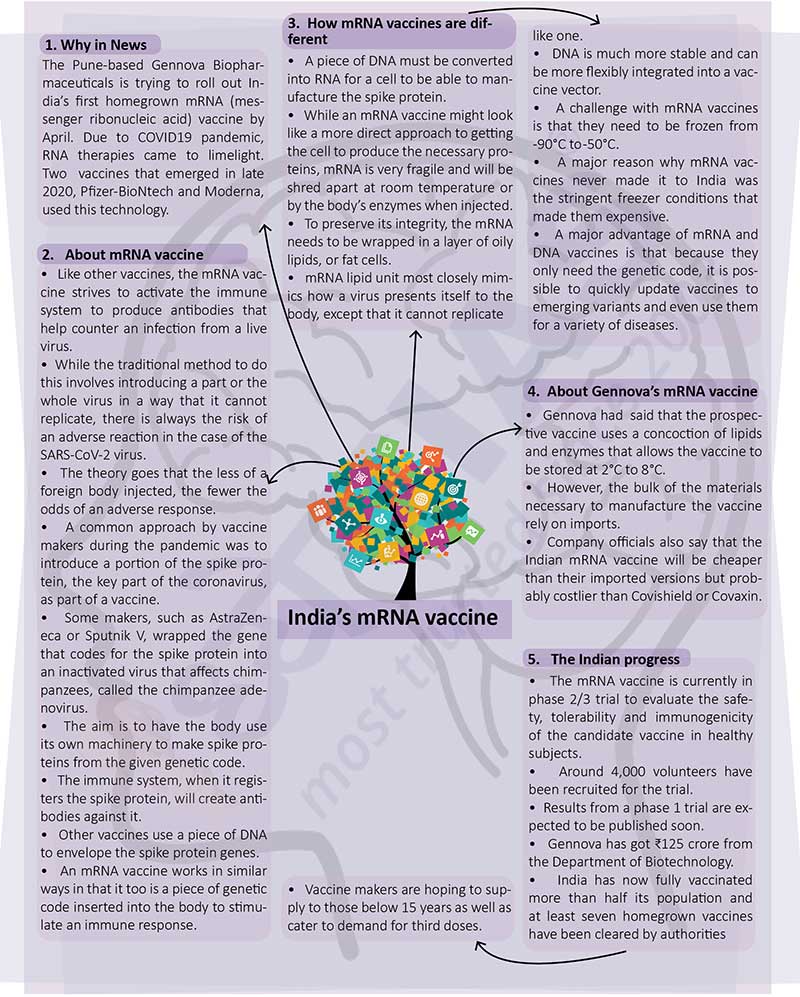Brain-booster
/
30 Mar 2022
Brain Booster for UPSC & State PCS Examination (Topic: India’s mRNA Vaccine)

Why in News?
- The Pune-based Gennova Biopharmaceuticals is trying to roll out India’s
first homegrown mRNA (messenger ribonucleic acid) vaccine by April. Due to
COVID19 pandemic, RNA therapies came to limelight. Two vaccines that emerged
in late 2020, Pfizer-BioNtech and Moderna, used this technology.
About mRNA vaccine
- Like other vaccines, the mRNA vaccine strives to activate the immune
system to produce antibodies that help counter an infection from a live
virus.
- While the traditional method to do this involves introducing a part or
the whole virus in a way that it cannot replicate, there is always the risk
of an adverse reaction in the case of the SARS-CoV-2 virus.
- The theory goes that the less of a foreign body injected, the fewer the
odds of an adverse response.
- A common approach by vaccine makers during the pandemic was to introduce
a portion of the spike protein, the key part of the coronavirus, as part of
a vaccine.
- Some makers, such as AstraZeneca or Sputnik V, wrapped the gene that
codes for the spike protein into an inactivated virus that affects
chimpanzees, called the chimpanzee adenovirus.
- The aim is to have the body use its own machinery to make spike proteins
from the given genetic code.
- The immune system, when it registers the spike protein, will create
antibodies against it.
- Other vaccines use a piece of DNA to envelope the spike protein genes.
- An mRNA vaccine works in similar ways in that it too is a piece of
genetic code inserted into the body to stimulate an immune response.
How mRNA vaccines are different
- A piece of DNA must be converted into RNA for a cell to be able to
manufacture the spike protein.
- While an mRNA vaccine might look like a more direct approach to getting
the cell to produce the necessary proteins, mRNA is very fragile and will be
shred apart at room temperature or by the body’s enzymes when injected.
- To preserve its integrity, the mRNA needs to be wrapped in a layer of
oily lipids, or fat cells.
- mRNA lipid unit most closely mimics how a virus presents itself to the
body, except that it cannot replicate like one.
- DNA is much more stable and can be more flexibly integrated into a
vaccine vector.
- A challenge with mRNA vaccines is that they need to be frozen from-90°C
to -50°C.
- A major reason why mRNA vaccines never made it to India was the
stringent freezer conditions that made them expensive.
- A major advantage of mRNA and DNA vaccines is that because they only
need the genetic code, it is possible to quickly update vaccines to emerging
variants and even use them for a variety of diseases.
About Gennova’s mRNA vaccine
- Gennova had said that the prospective vaccine uses a concoction of
lipids and enzymes that allows the vaccine to be stored at 2°C to 8°C.
- However, the bulk of the materials necessary to manufacture the vaccine
rely on imports.
- Company officials also say that the Indian mRNA vaccine will be cheaper
than their imported versions but probably costlier than Covishield or
Covaxin.
The Indian progress
- The mRNA vaccine is currently in phase 2/3 trial to evaluate the safety,
tolerability and immunogenicity of the candidate vaccine in healthy
subjects.
- Around 4,000 volunteers have been recruited for the trial.
- Results from a phase 1 trial are expected to be published soon.
- Gennova has got ₹125 crore from the Department of Biotechnology.
- India has now fully vaccinated more than half its population and at
least seven homegrown vaccines have been cleared by authorities.
- Vaccine makers are hoping to supply to those below 15 years as well as
cater to demand for third doses.







